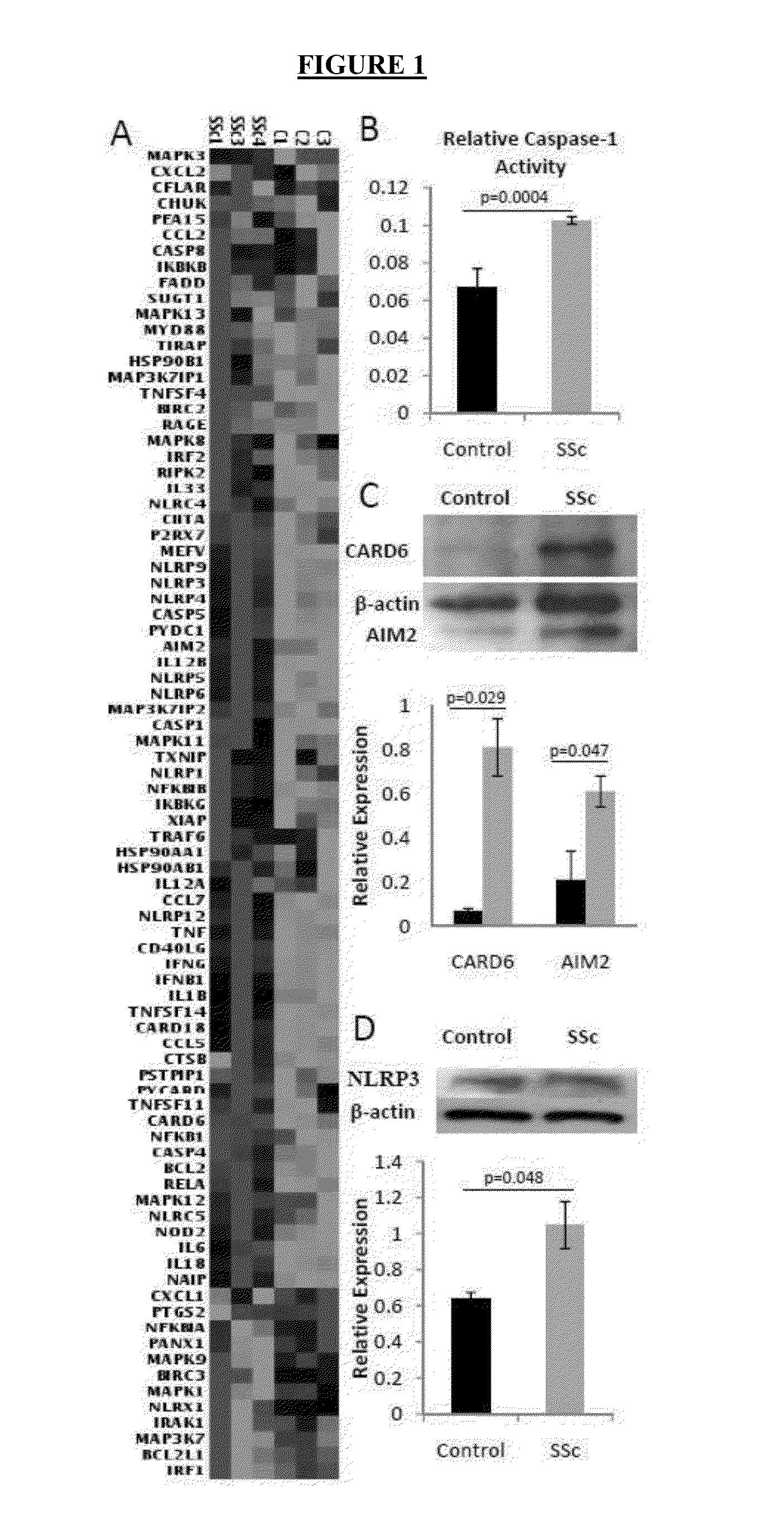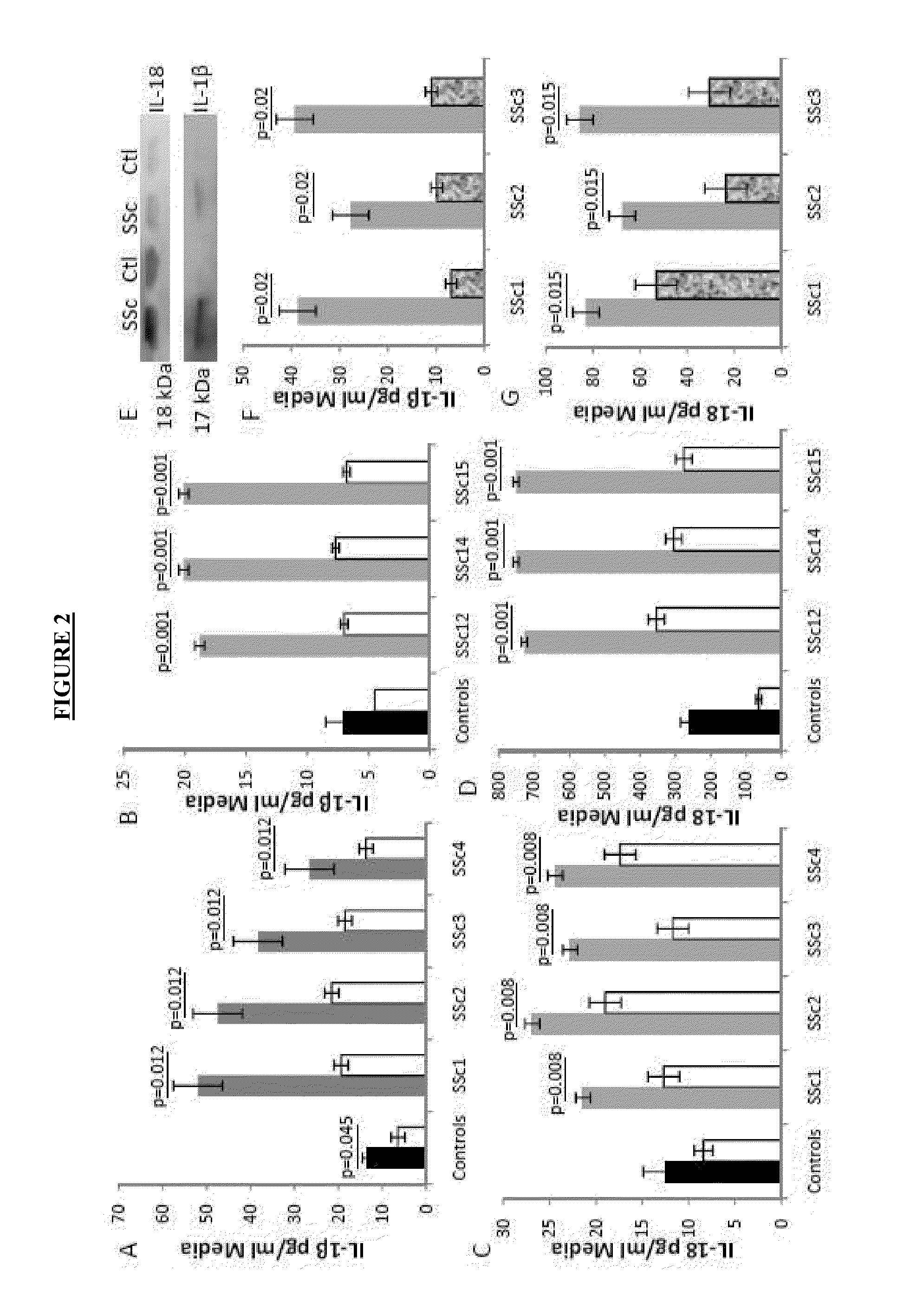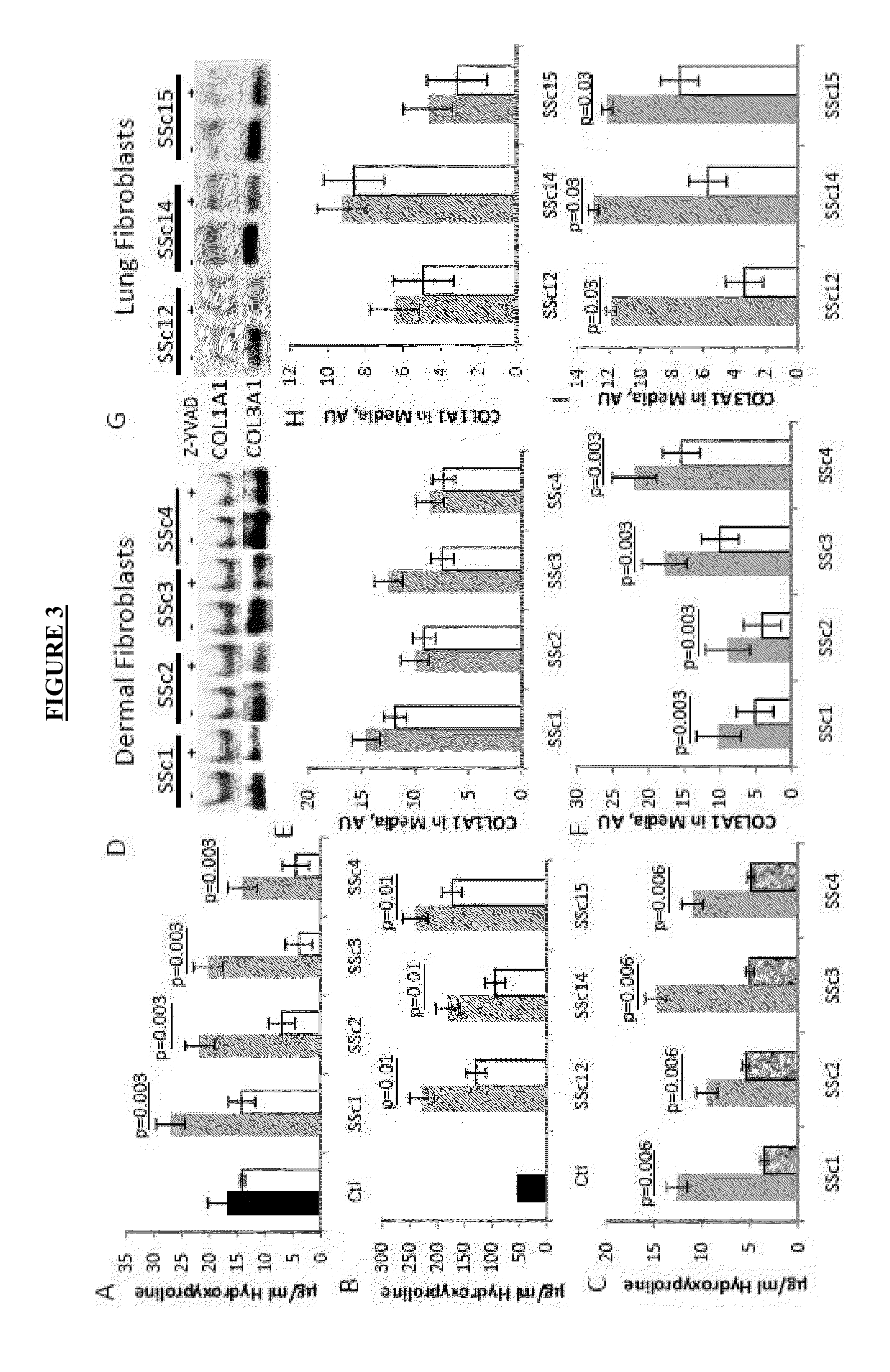Methods for treating or preventing fibrosis in subjects afflicted with scleroderma
a fibrosis and scleroderma technology, applied in the direction of phosphorous compound active ingredients, peptides, dna/rna fragmentation, etc., can solve the problems of excessive accumulation of collagen, no effective treatment, and death of patients afflicted with scleroderma
- Summary
- Abstract
- Description
- Claims
- Application Information
AI Technical Summary
Benefits of technology
Problems solved by technology
Method used
Image
Examples
example 1
Inflammasome Components and Downstream Signaling Molecules are Upregulated in SSc Dermal Fibroblasts
[0258]The gene expression of 84 genes involved in inflammasome signaling in three SSc dermal fibroblast lines and three normal dermal fibroblast lines was investigated by RT-PCR. In 8 SSc dermal fibroblasts 40 genes were upregulated more than 2-fold (FIG. 1A and Table 2), whereas only one gene (prostaglandin endoperoxidase 2) was downregulated more than 2-fold, compared to healthy fibroblasts. Activation of AIM2, NLRC4 / IPAF, NLRP1, or NLRP3 initiates the formation of distinct inflammasome scaffolds leading to activation of caspase-1 and cleavage of pro-IL-1β and pro-IL-18. AIM2 (p=0.017) and NLRP3 (p=0.028) expression is increased suggesting that at least two inflammasome signaling platforms may be activated in SSc fibroblasts. In addition, increased transcripts of IL-1β (p=0.02) and IL-18 (p=0.0019) were observed, consistent with the increased secretion of IL-1β and IL-18 by SSc fibr...
example 2
IL-1β and IL-18 Secretion by SSc Fibroblasts is Controlled by Caspase-1
[0259]In the light of the increased expression of inflammasome transcripts and caspase-1 activity in SSc dermal fibroblasts, the possibility of elevated secretion of IL-1β and IL-18 was investigated. Normal dermal fibroblasts (n=3) secreted 13.6±0.7 pg / ml of IL-1β whereas SSc dermal fibroblasts (n=4) secreted 41.1±5.6 pg / ml (p=0.014, FIG. 2A). When the Z-YVAD(OMe)-FMK inhibitor was added to the SSc dermal fibroblasts, IL-1β was reduced to 12.0±1.6 pg / ml (p=0.012), and was comparable to levels measured in normal dermal fibroblasts (p=0.08; FIG. 2A). Normal lung fibroblasts (n=3) secreted 3.3±0.5 pg / ml of IL-1β whereas SSc lung fibroblasts (n=3) secreted a 6-fold higher concentration, 19.7±0.4 pg / ml (p=0.006; FIG. 2B). In the presence of the caspase-1 inhibitor the secreted IL-1β by SSc lung fibroblasts was reduced to 7.2±0.2 pg / ml (p=0.001; FIG. 3B), within the normal levels of non-fibrotic lung fibroblasts (p=0.2...
example 3
Collagen Expression in SSc Fibroblasts is Regulated by Caspase-1
[0261]IL-1β and / or IL-18 can mediate collagen expression via the induction of TGF-β1, therefore the possibility of whether inhibiting caspase-1 with Z-YVAD(OMe)-FMK or siRNA could reduce collagen expression was investigated. Normal dermal fibroblasts (n=3) secreted 9.7±2.19 pg / ml, whereas SSc dermal fibroblasts (n=4) secreted 18.73±2.33 μg / ml hydroxyproline (FIG. 3A; p=0.03). SSc dermal fibroblasts treated with Z-YVAD(OMe)-FMK decreased the secretion of hydroxyproline to 5.19±0.94 μg / ml (p=0.003; FIG. 3A), but not statistically significant when compared with averaged normal dermal fibroblasts (p=0.5).
[0262]To further confirm the role of caspase-1 in SSc fibroblast collagen production, the production of COL1A1 and COL3A1 proteins was examined by western blotting. Secreted COL1A1 protein was decreased with the Z-YVAD(OMe)-FMK inhibitor from 11.4±1.3 arbitrary units (AU) to 8.9±1.0 AU (FIG. 3D&E). There was a trend for the...
PUM
 Login to View More
Login to View More Abstract
Description
Claims
Application Information
 Login to View More
Login to View More - R&D
- Intellectual Property
- Life Sciences
- Materials
- Tech Scout
- Unparalleled Data Quality
- Higher Quality Content
- 60% Fewer Hallucinations
Browse by: Latest US Patents, China's latest patents, Technical Efficacy Thesaurus, Application Domain, Technology Topic, Popular Technical Reports.
© 2025 PatSnap. All rights reserved.Legal|Privacy policy|Modern Slavery Act Transparency Statement|Sitemap|About US| Contact US: help@patsnap.com



